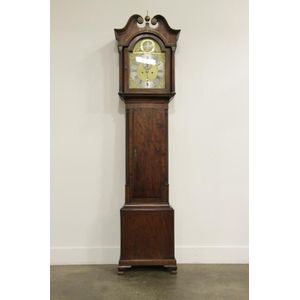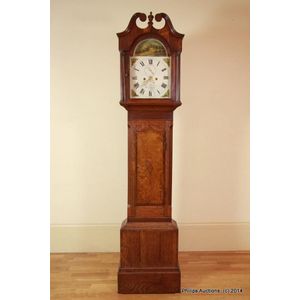George III Mahogany Longcase Clock by C. Fenwick (1826)
You must be a subscriber, and be logged in to view price and dealer details.
Subscribe Now to view actual auction price for this item
When you subscribe, you have the option of setting the currency in which to display prices to $Au, $US, $NZ or Stg.
- Mahogany - Mahogany is a dense, close grained red-coloured timber from the West Indies and Central America. It was first imported into Europe in the the early 18th century and its use continued through the 19th century. It was popular for furniture making because of its strength, the wide boards available, the distinctive grain on some boards, termed flame mahogany and the rich warm colour of the timber when it was polished.. The "flame" was produced where a limb grew out from the trunk of the tree, and this timber was usually sliced into veneers for feature panels on doors, backs and cornices.
Some terms used to describe mahogany relate to the country from which it originally came, such as "Cuban" mahogany, "Honduras" mahogany etc. However unless the wood has been tested the names assigned are more a selling feature, rather than a true indication of the timber's origin. - Canted Corners - In decorative arts, especially furniture making, a canted corner refers to a technique where the corner of the piece is angled or "canted" to create a diagonal corner. This is different from a chamfered corner which is a technique where the edges of a corner are cut at an angle, creating a diagonal edge or "bevel" along the corner.
A canted corner is typically used to add visual interest to the item. It can be found in various styles of furniture such as contemporary, Art Deco, or traditional. It is often used to create a sense of movement and dynamism in a piece.
Canting a corner is a more complex technique than chamfering, and it is typically done by tilting the corner of a piece of furniture and then cutting the wood to match the angle. It's a technique that requires precise measurements and a good understanding of angles and geometry, and it is usually done by experienced artisans. - George Iii - George III (1738 - 1820) was King of Great Britain and Ireland from 1760 to 1820.
- Date Aperture - A date aperture is a cut out section in the face of a watch or clock, displaying the day of the month.
- Movement - The technical name for the workings of a clock or watch, and does not include the dial or case.
This item has been included into following indexes:
Visually similar items

George III oak longcase clock by Thomas Brown of Birmingham, circa 1780, eight day, brass brake, arch dial, small seconds hand, date disk, striking on bell, London style hood, with key, 260 cm height

An early 19th century mahogany cased grandfather clock the brass dial with a silvered chapter ring signed Geo. Bruce London. Height 218 cm. Width 45 cm. Depth 22 cm

An English oak provincial longcase clock 19th century, maker Walker & Hughes, Birmingham. a swan's neck pediment above an arched painted dial with Roman numerals and a seconds dial and date aperture, a painted manor house and pastoral scene and decorative

An English 18th century oak and mahogany cross banded eight day grandfather clock. Maker: Simpson of Lincoln. 210 cm high, 43 cm wide, 20 cm deep.
